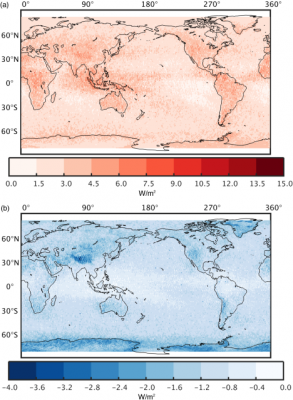Neglecting Longwave Scattering Yields Significant Earth System Model Biases
This paper systematically evaluates the bias in Earth System Models that is introduced by neglecting the known physics of atmospheric multiple scattering in longwave radiative transfer routines. Because most Earth System Model radiative transfer routines ignore multiple scattering in order to reduce their computational expense, this work evaluates both the spatial and spectral distribution of biases in these routines by comparing flux and heating rate simulations with and without multiple scattering. This comprehensive comparison was performed with observationally-derived atmospheric state information at a global scale, with a special emphasis on the distributions of the macro- and microphysical properties of clouds as derived from existing satellite-instrument products.
This paper finds that the lack of multiple scattering in Earth System Model longwave radiative transfer is problematic in that non-scattering solvers will overestimate TOA flux and underestimate surface flux globally by 2.6 and 1.2 W/m2, respectively. Much larger regional biases can be as large as 10% of local OLR, and these biases are most prominent along the ITCZ and at high altitudes. Furthermore, the evaluation of wavelength-dependent biases indicates that they vary significantly in the spectral dimension and are most prominent over wavelengths from 20 to 28 μm. These findings strongly motivate the inclusion of multiple scattering in Earth System Model longwave radiative transfer parameterizations.
Longwave radiative transfer parameterizations in Earth System Models must balance computational expense with accuracy. While previous studies presented an analysis of limited scope to motivate the inclusion of multiple scattering in these parameterizations, where it is currently lacking, this work, published in Journal of Advances in Earth System Modeling, presents a comprehensive analysis to quantify the sign and magnitude of the bias associated with omitting this known, but computationally expensive, physics. Radiative transfer parameterizations both with and without multiple scattering are performed with observationally-derived atmospheric state information, including cloud properties. Because the size of the error is comparable to the signal arising from a doubling of atmospheric carbon dioxide, Earth System Models must include multiple scattering to avoid significant, and avoidable, errors, despite their computational expense.

